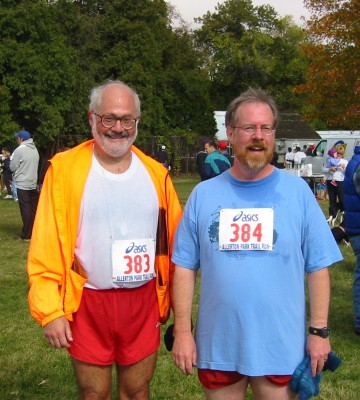Last month I posted a bit on endocannabinoid production in cursorial mammals, pointing to an article on new research that both supports the hypothesis that endocannabinoids are responsible for runners high, and that the whole system may have evolved to encourage and facilitate long-distance running in mammals whose success depends on it.
I found that I was still quite interested in endocannabinoids and running, and a little more research brought me to this 2004 survey paper by A Dietrich and W F McDaniel in the British Journal of Sports Medicine, endocannabinoids and exercise. It turns out endocannabinoids are involved in a whole range of systems, both centrally in the brain and peripherally in the rest of the body.
Some of the things that endocannabinoids do are entirely to be expected by anyone who has any experience with exogenous cannabinoids: pain relief, sedation, reduced anxiety, euphoria, and a general sense of wellbeing.
But other things were new to me:
- Anandamide, a particular endocannabinoid, prevents edema and inflammation—probably a very useful mechanism. After all, running is bound to produce minor tissue damage to the feet and legs. Those endocannabinoids probably greatly reduce the need to get clever with ice and elevation and compression and anti-inflammatory drugs.
- Anadamide also acts as a vasodilator and produces hypotension, perhaps facilitating blood flow during exercise.
- Although in large doses cannabinoids produce motor inhibition, in low doses they produce increased locomotion. It appears that they make it easier to perform motor skills that have been practiced to the point where performance is automatic, such as running.
- Cannabinoids act as brochodilators, perhaps facilitating breathing during exercise.
On that last point, I’ve certainly noticed that going for a run produces a profound relaxation of my upper airways. My nasal passages are pretty much permanently inflamed due to allergies—to the point that I spent most of last year needing to use a nasal steroid spray if I wanted to be able to breath through my nose. I have no idea if it’s mediated by endocannabinoids, but my nose is much, much more open after a run than it is before a run, and the effect lasts for hours.
One thing I found particularly interesting was an explanation for why cannabinoids don’t seem to be very addictive. They’re involved in the same dopamine systems that other addictive drugs are, and by rights ought to produce withdrawal symptoms when they’re withdrawn. In fact, you can produce those symptoms (in rats), by habituating the rats to THC and then administering an antagonist that blocks cannabinoid receptors. But mere withdrawal of the drug won’t do it, apparently because the drug hangs around in the system for so long that even abrupt withdrawal ends up resulting in a gradual tapering off.
On the other hand, gradual withdrawal is still withdrawal—even if it’s not drastic enough to produce shakes—and endocannabinoids may explain not only runners high, but also the addictive behaviors reported in runners:
We do not suggest that the addictive aspects of exercise are identical with the addictive properties of exogenous cannabinoids, but that a similarity exists between the desire that some people have for exercise and the desire they may have for exogenous administrations of cannabinoids. The parallels between these results and the subjective experiences associated with exercise abstinence, as discussed previously, are considerable.
What led me to this paper in the first place was a desire to get some data on just how much exercise was necessary to start producing endocannabinoids. On that question, the paper does provide a datapoint:
Using trained male college students running on a treadmill or cycling on a stationary bike for 50 minutes at 70–80% of maximum heart rate, we found that exercise of moderate intensity dramatically increased concentrations of anandamide in blood plasma.
That sounds pretty reasonable, although I wish they had data for exercise for 10 to 40 minutes as well. My guess, based on reports of runners high, is that it does take upwards of 50 minutes to start seeing a significant increase, but it’s just a guess. It’d be nice to have some data.
Most unconditioned people can’t maintain 70–80% of maximum heart rate for 50 minutes, meaning that if it’s true that it takes 50 minutes, most people won’t be able to experience this “dramatic” increase. The typical sedentary person would probably have to train for weeks to achieve this level of performance.
So far this year, my longest run was 26 minutes. But it was a great run (unlike my first long runs of the previous two years, which were not entirely successful). I’m quite optimistic that I’ll be able to ramp up the distance without much difficulty.



